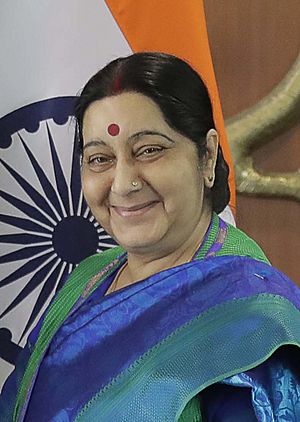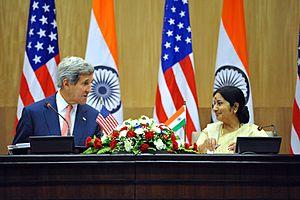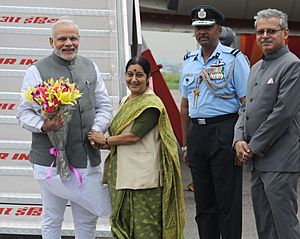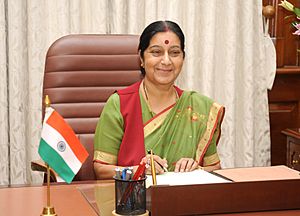Sushma Swaraj facts for kids
Quick facts for kids
Sushma Swaraj
|
|
|---|---|

Official portrait, 2014
|
|
| 29th Minister of External Affairs | |
| In office 26 May 2014 – 30 May 2019 |
|
| Prime Minister | Narendra Modi |
| Preceded by | Salman Khurshid |
| Succeeded by | Subrahmanyam Jaishankar |
| Minister of Overseas Indian Affairs | |
| In office 26 May 2014 – 7 January 2016 |
|
| Prime Minister | Narendra Modi |
| Preceded by | Vayalar Ravi |
| Succeeded by | Office abolished |
| Leader of the Opposition in the Lok Sabha | |
| In office 21 December 2009 – 26 May 2014 |
|
| President | Pratibha Patil Pranab Mukherjee |
| Preceded by | L. K. Advani |
| Succeeded by | Vacant |
| Minister of Parliamentary Affairs | |
| In office 29 January 2003 – 22 May 2004 |
|
| Prime Minister | Atal Bihari Vajpayee |
| Preceded by | Pramod Mahajan |
| Succeeded by | Ghulam Nabi Azad |
| Minister of Health and Family Welfare | |
| In office 29 January 2003 – 22 May 2004 |
|
| Prime Minister | Atal Bihari Vajpayee |
| Preceded by | C. P. Thakur |
| Succeeded by | Anbumani Ramadoss |
| Minister of Information and Broadcasting | |
| In office 30 September 2000 – 29 January 2003 |
|
| Prime Minister | Atal Bihari Vajpayee |
| Preceded by | Arun Jaitley |
| Succeeded by | Ravi Shankar Prasad |
| 5th Chief Minister of Delhi | |
| In office 13 October 1998 – 3 December 1998 |
|
| Lieutenant Governor | Vijai Kapoor |
| Preceded by | Sahib Singh Verma |
| Succeeded by | Sheila Dikshit |
| Member of Parliament, Lok Sabha | |
| In office 31 May 2009 – 24 May 2019 |
|
| Preceded by | Rampal Singh |
| Succeeded by | Ramakant Bhargava |
| Constituency | Vidisha |
| In office 7 May 1996 – 3 October 1999 |
|
| Preceded by | Madan Lal Khurana |
| Succeeded by | Vijay Kumar Malhotra |
| Constituency | South Delhi |
| Member of Legislative Assembly, Haryana | |
| In office 1987–1990 |
|
| Preceded by | Ram Dass Dhamija |
| Succeeded by | Anil Vij |
| Constituency | Ambala Cantonment |
| In office 1977–1982 |
|
| Preceded by | Hans Raj Suri |
| Succeeded by | Ram Dass Dhamija |
| Constituency | Ambala Cantonment |
| Personal details | |
| Born |
Sushma Sharma
14 February 1952 Ambala Cantonment, Punjab, India (now in Haryana, India) |
| Died | 6 August 2019 (aged 67) New Delhi, India |
| Cause of death | Cardiac arrest |
| Political party | Bharatiya Janata Party |
| Spouse |
Swaraj Kaushal
(m. 1975) |
| Children | Bansuri Swaraj |
| Alma mater | Sanatan Dharma College (BA) Panjab University (LLB) |
| Profession | Senior advocate |
| Awards | Padma Vibhushan (2020) (posthumously) |
| Source: [1] | |
Sushma Swaraj (born Sushma Sharma; 14 February 1952 – 6 August 2019) was an Indian lawyer and a very important politician. She served as the Minister of External Affairs (Foreign Minister) for India from 2014 to 2019. She was part of the first government led by Prime Minister Narendra Modi.
Sushma Swaraj was a senior leader of the Bharatiya Janata Party (BJP). She was the second woman to hold the position of Foreign Minister, after Indira Gandhi. She was elected to the Parliament seven times and to the state assembly three times.
In 1977, at just 25 years old, she became the youngest cabinet minister in the Indian state of Haryana. She also served as the Chief Minister of Delhi for a short time in 1998. She was the first woman to become Chief Minister of Delhi.
In the 2014 Indian general election, Swaraj won her seat in Vidisha, Madhya Pradesh, by a huge number of votes. She became the Minister of External Affairs on 26 May 2014. The US newspaper Wall Street Journal once called her India's "best-loved politician." She did not run in the 2019 Indian general election because of health reasons.
Sushma Swaraj passed away on 6 August 2019, due to a heart attack. In 2020, she was given the Padma Vibhushan, which is India's second-highest civilian award, after her death.
Contents
Early Life and Education
Sushma Swaraj, whose birth name was Sushma Sharma, was born on 14 February 1952. She was born in Ambala Cantonment, Haryana. Her parents were Hardev Sharma and Shrimati Laxmi Devi. Her father was a member of the Rashtriya Swayamsevak Sangh. Her family originally came from Lahore, Pakistan.
She went to Sanatan Dharma College in Ambala Cantonment. There, she earned a bachelor's degree in Sanskrit and Political Science. She later studied law at Panjab University, Chandigarh. She was known for her excellent speaking skills. She won the best Hindi Speaker award for three years in a row in a state competition. Sushma Swaraj was also a strict vegetarian.
Advocacy and Early Political Steps
In 1973, Sushma Swaraj started working as a lawyer in the Supreme Court of India. Her political journey began in the 1970s with the Akhil Bharatiya Vidyarthi Parishad. Her husband, Swaraj Kaushal, was connected to the socialist leader George Fernandes. Sushma Swaraj joined Fernandes's legal team in 1975.
She actively took part in Jayaprakash Narayan's Total Revolution Movement. After a period known as the Emergency, she joined the Bharatiya Janata Party. She later became a well-known national leader for the BJP.
Political Journey and Key Roles
Early Political Career in Haryana
Sushma Swaraj was a member of the Haryana Legislative Assembly from 1977 to 1982. She won the Ambala Cantonment seat when she was only 25. She served again from 1987 to 1990.
In July 1977, she became a Cabinet Minister in the Janata Party Government. She was in charge of Labour and Employment from 1977 to 1979. Later, from 1987 to 1990, she was the Minister of Education, Food, and Civil Supplies. At 27, she became the State President of the Janata Party in Haryana.
In April 1990, she was elected to the Rajya Sabha, which is the upper house of India's Parliament. She stayed there until 1996.
Minister of Information and Broadcasting (1996)
In 1996, she served as the Union Cabinet Minister for Information and Broadcasting. This was during the 13-day government led by Prime Minister Atal Bihari Vajpayee.
Chief Minister of Delhi (1998)
After working in national politics, she became the fifth Chief Minister of Delhi in October 1998. She was the first woman to hold this important position in Delhi. She resigned from this role in December of the same year.
Minister of Information and Broadcasting (2000–2003)
In March 1998, she was re-elected to the 12th Lok Sabha from South Delhi. Under Prime Minister Vajpayee's second government, she became the Union Cabinet Minister for Information and Broadcasting. She also had extra duties for the Ministry of Telecommunications.
One of her important decisions was to declare film production as an industry. This made it easier for the Indian film industry to get bank loans. She also started community radio stations at universities. In September 1999, the BJP asked her to run against Sonia Gandhi in the 13th Lok Sabha election. She campaigned in the Kannada language in Bellary, Karnataka. Even though she got many votes, she lost that election.
She returned to Parliament in April 2000 as a Rajya Sabha member. She was again made Minister for Information and Broadcasting from September 2000 to January 2003.
Minister of Health & Family Welfare (2003–2004)
From January 2003 to May 2004, she was the Minister of Health, Family Welfare. She was also the Minister of Parliamentary Affairs. This was until the National Democratic Alliance government lost the general election.
As the Union Health Minister, she helped set up six new All India Institute of Medical Sciences (AIIMS) hospitals. These were built in cities like Bhopal, Bhubaneshwar, Jodhpur, Patna, Raipur, and Rishikesh. In April 2006, Swaraj was re-elected to the Rajya Sabha for a third time. She served as the Deputy Leader of the Opposition in the Rajya Sabha until April 2009.
Leader of Opposition, Lok Sabha (2009–2014)
In the 2009 election, she won the 15th Lok Sabha seat from Vidisha, Madhya Pradesh. She won by a very large number of votes. Sushma Swaraj became the Leader of Opposition in the 15th Lok Sabha on 21 December 2009. She held this position until May 2014, when her party won a big victory in the general election.
Minister of External Affairs (2014–2019)


Sushma Swaraj served as India's Foreign Minister under Prime Minister Narendra Modi. Her term was from May 2014 to May 2019. She was in charge of India's foreign policy during this time. She was only the second woman to hold this important role.
As Foreign Minister, she helped many Indian citizens who were in trouble abroad. For example, she played a key role in bringing back a young Indian girl named Gita. Gita was hearing and speech-impaired and had been stuck in Pakistan for 15 years. This act was widely praised.

Achievements and Recognitions
In 1977, Sushma Swaraj became the youngest Cabinet Minister in the Government of Haryana at 25. In 1979, she became the State President of the Janata Party in Haryana at 27. She was also the first female Spokesperson for a national political party in India.
She holds many "firsts" for the BJP. She was the party's first female Chief Minister, Union Cabinet Minister, general secretary, Spokesperson, Leader of Opposition, and Minister of External Affairs. She is the first and only female Member of Parliament to receive the Outstanding Parliamentarian Award. She ran in 11 direct elections from four different states. She also led the Hindi Sahitya Sammelan in Haryana for four years.
In February 2016, during an international conference, Sushma Swaraj said that the Roma people were "children of India." The conference suggested that India should recognize the Roma community, who live in 30 countries, as part of the Indian diaspora. On 19 February 2019, Swaraj received the Grand Cross of Order of Civil Merit. This award was given by the Spanish government. It recognized India's help in evacuating Spanish citizens from Nepal during the 2015 earthquake.
Personal Life
Sushma Sharma married Swaraj Kaushal on 13 July 1975. He was also a lawyer at the Supreme Court of India. They met during the Emergency movement. Swaraj Kaushal later served as the Governor of Mizoram from 1990 to 1993. He was also a Member of Parliament from 1998 to 2004.
Sushma and Swaraj Kaushal had a daughter named Bansuri. Bansuri studied at Oxford University and became a Barrister at Law. Sushma Swaraj's sister, Vandana Sharma, is a political science professor. Her brother, Dr. Gulshan Sharma, is an Ayurveda doctor.
On 10 December 2016, she had a kidney transplant at AIIMS, Delhi. The surgery was successful.
Death
On 6 August 2019, Sushma Swaraj suffered a heart attack in the evening. She was taken to AIIMS New Delhi, where she later passed away. She was cremated the next day with full state honours in Delhi.
Awards and Honours
State Honours
 India:
India:
- Padma Vibhushan (posthumously) (2020)
 Spain:
Spain:
- Grand Cross of the Order of Civil Merit (19 February 2019)
Places Named After Her
- In 2020, the Government of India renamed the Foreign Service Institute of India after her. It is now called the Sushma Swaraj Institute of Foreign Service.
- Also in 2020, the Pravasi Bharatiya Kendra was renamed Sushma Swaraj Bhawan.
- The bus station in Ambala City was named after her in 2020.
Images for kids
-
Secretary of State John Kerry and Sushma Swaraj address reporters during news Conference following strategic dialogue
-
Sushma Swaraj addressing at 73rd United Nations General Assembly in 2018
-
Swaraj with Prime Minister Narendra Modi
See also
 In Spanish: Sushma Swaraj para niños
In Spanish: Sushma Swaraj para niños
- List of foreign ministers in 2017
- List of current foreign ministers









